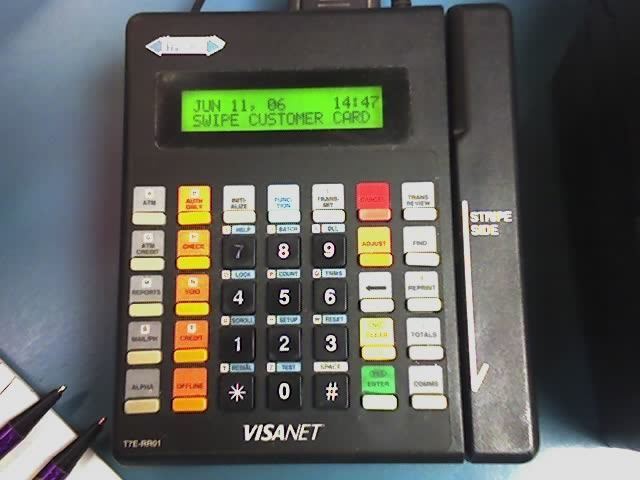 | ||
A payment terminal, also known as a point of sale terminal, credit card terminal, EFTPOS terminal (or a PDQ terminal in the United Kingdom), is a device which interfaces with payment cards to make electronic funds transfers.
Contents
There are various types of terminals available to merchants, although most have the same basic purpose and functions. They allow a merchant to insert, swipe, or manually enter the required credit/debit card information, to transmit this data to the merchant service provider for authorization and finally, to transfer funds to the merchant. Most newer models not only process credit and debit cards but can also handle gift cards, cheques, and so on. The majority of card terminals transmit data over a standard telephone line or a wired or wireless Internet connection. Some also have the ability to cache transactional data to be transmitted to the gateway processor when a connection becomes available; the major drawback to this is that immediate authorization is not available at the time the card was processed, which can subsequently result in failed payments. Remote wireless terminals can transmit card data using either cellular or satellite networks.
A merchant can replace the functionality of dedicated credit card terminal hardware using a terminal application running on a PC or mobile device, such as a smartphone. They usually work with dedicated hardware readers that can transfer magnetic stripe data to the application, while there are also some that also work with smart cards (using technology such as EMV), although this is rarely seen on smartphone readers. In case the necessary hardware is unavailable, these applications usually support manual entry of the card number and other data. In addition, more and more devices are beginning to offer built-in RFID or NFC technology to accommodate contactless or mobile device payment methods, often without requiring additional external hardware.
By moving to the use of card terminals to directly capture card information instead of manually entering in card details, merchants benefit from the efficiency of decreased transaction processing times. Previously, merchants could obtain lower processing costs by processing chip cards instead of Magnetic stripe cards. On the contrary, security is particularly of concern to such users: PCI DSS requirements need to be considered when using unsecured and unencrypted systems based on generic or open platforms; cardholder data security is integral to mandatory merchant PCI compliance. Several high profile breaches resulting in mass theft of cardholder data have occurred in the past due to the point of sale malware where people have accessed data stored insecurely on bespoke or custom systems operated by merchants.
History
Prior to the development of payment terminals, merchants would use Manual Imprinters also known as ZipZap machines to capture the information from the embossed information on a credit card onto a paper slips with carbon paper copies. These paper slips had to be taken to the bank for processing, this was cumbersome and time consuming process.
Point of sale terminals emerged in 1979, when Visa introduced a bulky electronic data capturing terminal which was the first payment terminal. In the same year magnetic stripes were added to credit cards for the first time. This allowed card information to be captured electronically and led to the development of payment terminals.
One of the first companies to produce dedicated payment terminals was Verifone. It started in 1981 in Hawaii as a small electronic company. In 1983 they introduced the ZON terminal series which would become the standard for modern payment terminals.
Hungarian born George Wallner in Sydney, Australia founded rival Hypercom in 1978 and in 1982 started producing dedicated payment terminals. It went on to dominate the south pacific region. In 1988 the company signed a deal with American Express to provide its terminals to them in the US. To consolidate the deal, Hypercom moved its head office from Australia to Arizona in the US. It then faced head to head competition with VeriFone on its home market.
Over a decade later in 1994 Lipman Electronic Engineering, Ltd. was established in Israel. Lipman manufactured the Nurit line of processing terminals. Because of Verifone’s already firm place in the payment processing industry when Lipman was established, Lipman targeted an untapped niche in the processing industry. While, Lipman holds about a 10% share in wired credit card terminals, they are the undisputed leader with more than 95% share in wireless processing terminals in the late 1990s.
Verifone would later acquired both of these major rivals, acquiring Lipman in 2006 and the payment part of the Hypercom business including its brand in 2011.
In 1980 Jean-Jacques Poutrel and Michel Malhouitre in 1980 established Ingenico in France and developed their first payment terminal in 1984. It's Barcelona based R&D unit would lead the development of payment terminals for the next decade. Ingenico through a number of acquisitions would dominate the European market for payment terminals. They acquired French based Bull and UK based De La Rue payment terminal activity as well as German Epos in 2001.
Initially, information was captured from the magnetic strip on the back of the card, by swiping the card through the terminal. In the late 1990s, this started to be replaced by smart cards where the chip was embedded in the card. This was done for added security and required the card to be inserted into the credit card terminal. In the late 1990s and early 2000s contactless payment systems were introduced and the payment terminals were updated to include the ability to read this these cards using near field communication (NFC) technology.
